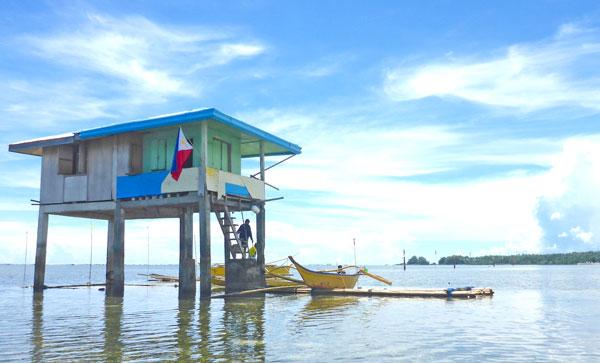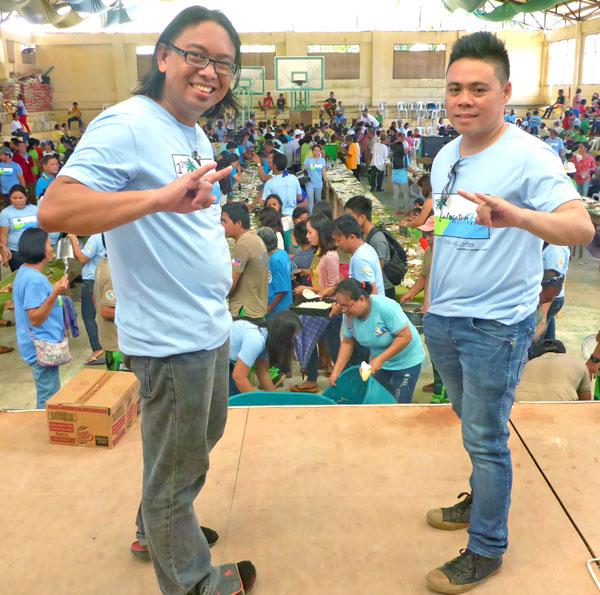It’s a sunny morning in the fishing village of Burgos. Our narrow banca, a small and simply constructed boat common to the Philippines, glides past a maze of fish corrals toward a guardhouse standing in the waters of the village’s marine sanctuary. Colored flags mark the sanctuary’s boundaries, fluttering in the cool breeze. The 67-hectare sanctuary is a no-take zone, which means that fishing is only allowed outside the boundaries. For the third year in a row, this sanctuary has won Burgos the “Best Marine Sanctuary” award in the coastal town of Cortes. From a banca, it’s easy to see why: healthy reefs fill the sanctuary’s clear waters, and thick mangrove forests line the shore.

The sanctuary’s success reflects the dynamism of wider Cortes, in which Burgos lies to the north. Last year, Cortes, a relatively small town in the province of Surigao del Sur, surprised hundreds of coastal municipalities in the Philippines when it became the first winner of the “Malinis at Masaganang Karagatan” or “Outstanding Coastal Community” award from the national government’s Bureau of Fisheries and Aquatic Resources.
The awards are far from a fluke for Cortes and Burgos. A diverse group of players is giving the community a solid chance to achieve sustainable and healthy coastal fisheries. Among them, there are townspeople like Mary Jean Pame, a member of Kaampaka, a community organization that cracks down on illegal fishing inside the Burgos sanctuary. There are local government officials like the passionate, young Mayor William Angos, who has vigorously championed marine conservation and sustainable fishing since taking office in Cortes. And there are catalytic local leaders like Vincent Dueñas, who de-signed a local campaign with Rare to revitalize appreciation of marine resources.
Together, these people and the organizations and institutions they represent have made the area a marker of hope for marine conservation and sustainability in the Philippines.
The Keeper: Mary Jean Pame
On a good day, licensed fishers can catch up to 30 kilograms of fish in the waters outside the Burgos sanctuary, says Mary Jean Pame, a member of Kaampaka (short for Kadagatan Ampingan Pagmata Katawhan, or “Protect our seas, people arise”). For some fishers, however, the temptation to stray toward the restricted grounds inside the sanctuary’s boundaries is too great. There, they can find commercially valuable species like danggit and lapu-lapu. “The fish inside the sanctuary are really big,” says Pame. “That’s why illegal fishers come and steal them.”
The community organization vigilantly conserves Burgos’ marine resources. Its members take turns at the Burgos guardhouse, on the lookout for fishers who encroach on the sanctuary. They take photos of violations and record everything in a logbook, which they submit to the Cortes government’s Civil Society Development Office.
The community organization vigilantly conserves Burgos' marine resources. Its members take turns at the Burgos guardhouse, on the lookout for fishers who encroach on the sanctuary.
Dialogue with erring fishers is the preferred mode of resolving conflicts, though, and the guards don’t carry guns. “It’s good not to quarrel with or reprimand them because they will harbor ill will,” says Pame of dealing with the violations. “If many of them attack us, we’re going to lose because we’re only a small group,” adds Inocencio Cabuga, the 70-year-old manager of Kaampaka. The group started with five members in 1998 and reached a peak of more than 60, but their numbers dwindled after they were threatened by illegal fishers, who burned down their watchtower in 2001.
Kaampaka founder and chairman Benjamin Dellosa wrote about the incident in a poem displayed prominently inside the guardhouse, a constant reminder of the challenges they have overcome. Around 30 members are currently active, sharing a minimal allowance from the municipal government for guarding the sanctuary around the clock.
The Vanguard: Mayor William Angos
Mary Jean Pame says local residents credit the transformation of Cortes from a sleepy coastal town to a national winner to their youthful leader, Mayor William Angos, who has driven new momentum in marine conservation since he took office in 2013.
Inside the mayor’s office, 42-year-old Angos receives visitors at a long worktable he shares with senior staff, clicking away on their laptops. Trading his suit and tie for t-shirts and open sandals, he cuts a maverick figure, with long hair and a calm demeanor. Angos left his previous life as a corporate lawyer, certified public accountant, and college teacher in Davao City to embark on an adventure in local governance in his hometown.
The path to national recognition for Cortes wasn’t easy, says Angos. He recalls a litany of basic needs that had to be addressed before the town’s fishers and farmers latched onto the sustainable fisheries bandwagon. “I thought it was going to be a vacation,” Angos says with a laugh.
He was initially attracted to the job by the ecotourism potential of Cortes. The town has become a popular destination in recent years because of Laswitan waterfalls, a natural rock pool on the coast that attracts hordes of selfie-seeking visitors during the peak season from November to January. Angos became concerned that unregulated tourism development – including a toilet and concrete structures built right on the craggy shoreline, buffeted by Surigao’s famous surfing waves – would destroy its natural beauty.
Right after his election, Mayor Angos started working to safeguard local natural treasures. Under Angos’ leadership, the municipal government spent five million pesos rehabilitating Laswitan Falls. Law enforcement also went after illegal fishers, with almost 700 fishers giving up banned gear like beach seine and dragnet.
The marine conservation projects in Cortes have resulted in higher environmental awareness among residents. However, illegal fishing persists, and Mayor Angos believes this is due to a lack of financial resources and basic services. “Unless you address their hunger pangs, they will keep abusing our environment,” he says.
We needed to deepen our understanding of the people, and make sure the government responds to their daily needs before trying to introduce concepts such as habitat protection.
Vincent Dueñas, Rare Fellow
From providing school buses and dental kits for children to vocational training for jobless youth, Angos went through a trial-and-error process until he managed to get Cortes on track to balancing environmental protection with economic productivity. With very few jobs in town, training centers for skills like carpentry and masonry were set up for some 2,000 out-of-school youth. Angos also found interest among high school students in dragon boat racing, a team paddling sport and a natural fit for kids who grew up paddling boats with their parents in vast coastal waters. Angos is raising funds to develop a strong team, and create a “fighting chance for locals to get varsity scholarships” if they want to go to college.
Looking back, it’s a good thing Angos got to work from day one as mayor, he says. “After two years, we were able to produce results,” says Angos. The municipal government’s campaign to better provide for basic needs and look at “conservation as a social problem” won over the judges in BFAR’s search for “Outstanding Coastal Community,” giving a windfall of 20 million Philippine pesos (around $400,000 USD) to Cortes for its livelihood projects.
Along the way, Angos has seen how significant community-based fishing will be to improving livelihoods. With increased enforcement of marine protections, fish abundance increased in coastal waters and a growing number of residents found fishing to be a lucrative source of income to supplement local coconut farming. From 600 registered fishers in 2013, the number has soared to more than 3,000 fishers. Angos recognized that this was what much of the youth of his town really wanted to do, over receiving technical education. “Culturally, they have been really into fishing for a long time,” he says.
Drawing from this insight, Angos is trying to make use of the town’s boat-building tradition and skills to enable fishers to make vessels that can go out to deeper waters. Doing so could reduce fishing pressure near the shore, and allow the population of the most vulnerable fish species to recover and grow to adult sizes.
The Helping Hand: Vincent Dueñas

Rare Fellow Vincent Dueñas hopes to plant seeds for a deeper, more widespread conservation ethic in Cortes. Dueñas is the head of the coastal resource management, tourism and civil society offices in the Cortes government. These days, when he thinks through ways to motivate sustainable fishing and conservation, incentives are key.
One of his recent ideas is the Ultimate Fishers’ Champion, an innovative local contest that tests practical skills and environmental awareness. During the celebration of the Araw ng Cortes (Foundation Day) last October, the municipal government used some of its “Outstanding Coastal Community” award funds from the Bureau of Fisheries and Aquatic Resources to provide cash prizes to the winners of the Ultimate Fishers’ Champion.
Dueñas was one of the first Rare Fellows, working with international conservation organization Rare in the Philippines to locally promote sustainable fisheries. In 2010, Dueñas designed a local campaign to bolster appreciation of marine resources in Cortes through creative social marketing means, such as festivals and a costumed fish mascot named Rabita (named after the rabbitfish, a valuable species in Cortes fishing).
The more he engaged with the community in the course of the campaign, Dueñas found that his fellow townspeople were looking for tangible rewards for changing their behavior toward the environment. “We needed to deepen our understanding of the people, and make sure the government responds to their daily needs before trying to introduce concepts such as habitat protection. We need to do profiling not just of the fishers but also the farmers, who are turning to fishing due to higher fish abundance,” he said.
Dueñas has been working alongside Mayor Angos to find solutions that address the basic needs of Cortes residents, while persuading them to protect the sources of their livelihood. “Social marketing is only effective if it has benefits,” says Dueñas. “The problem with some environmentalists is that they only look at natural resources and not people.”
Pointing to several boxes stacked on the floor of his office, Mayor Angos says they contain donations of dental kits that will be distributed to children. “If we don’t have kids with toothaches, that already has a huge impact on one family’s economic condition,” he says.
Cortes was once merely a barangay, or village, blended into what is now the capital city of Tandag. Going forward, Angos strives to turn Cortes into a thriving trading post. The potential is there: the community is a major producer of premium seafood such as crabs, prawns, and lobsters. A fish landing center and ice plant are also opening soon in the village of Tigao. The challenge for Cortes will be ensuring that marine catch doesn’t exceed the capacity of the sea to replenish the resources.
Yasmin Arquiza is the Senior Communications Manager for Rare in the Philippines. Click here for more information on Rare’s work in the country.